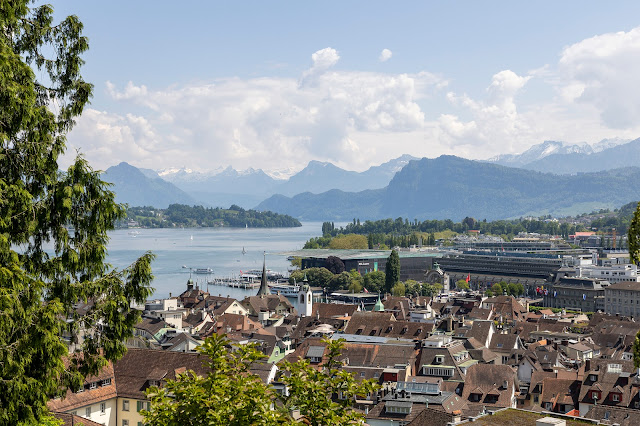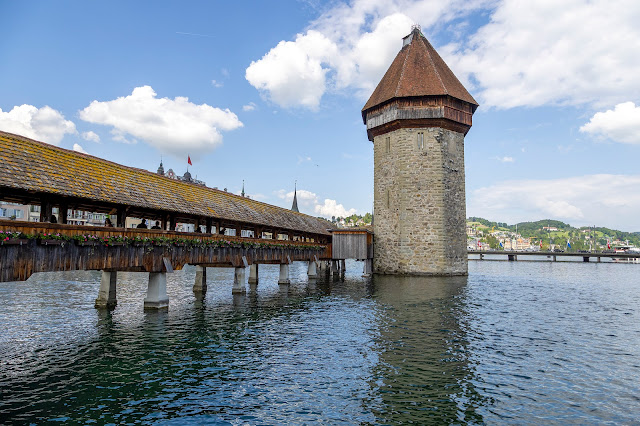Hotel De La Pays was just 3 tram stops away and attached to a restaurant. We were warmly greeted by the young male receptionist and told our first floor room was ready even though we were a little early. It was probably one of the tiniest rooms we've ever stayed in, barely room for the double bed but it was clean and the bed extremely comfortable and it was only for one night. We had a quick cuppa in the room, thanks to my very old travelling water heater, and then set out to find the nearest supermarket for some wine for later, which turned out to be a Co-Op just around the corner so we were able to drop the goodies back to our room.
Situated on the shores of Lake Lucerne, Lucerne (or Luzern as it's in the German-Swiss speaking region, much to Ian's surprise) this is a delightful old city with some buildings dating back to 14th century. On the hillside behind our hotel is the Musegg Wall with its 9 towers; these are part of the city's historic fortifications and 3 of the towers can be climbed. We went part way up one but the views were a little hazy and so we decided not to use up Ian's limited energy going inside the others.
I couldn't recognise the tune.
There are two covered medieval bridges spanning the River Reuss; this one is the Spreuer Bridge, completed in 1408 but then destroyed by floods and rebuilt in 1566 with a granary as the bridge head.
The woodwork is very ornate and there are pictures on some of the gables.
It was too busy to take the whole sequence, but they all featured the skeleton in various guises.
The Reuss weir is one of the last remaining needle dams in the world and it maintains both the water level and the flow of the river through a series of thin pieces of wood (needles). It was originally built in 1859 and in 1998 the hydroelectric power plant was completely modernised and produces enough electricity to power around 1,500 households. A further renovation about 15 years ago resulted in greater flood protection for the lake and the river, preservation of the dam and better living conditions for the plants and animals.
Some of the older buildings are just lovely.
The other, more famous of Lucerne's bridges, is the Chapel Bridge which was built in 1333 and is the oldest covered wooden bridge in Europe and the world's oldest surviving truss bridge. Originally 270m long but shortened over the years to around 205m it is rather impressive and so I took numerous photos!
Once again, the gables are decorated. Some of the paintings date back to 17th century although many were lost in a fire in 1993 which almost destroyed the whole bridge.
The octagonal tower was built as part of the city wall and used as an archive, treasury, prison and torture chamber. Today, the middle floor is home to the headquarters of the Lucerne Artillery Association. Meanwhile, a colony of Alpine Swifts has been roosting under the rooftop for decades. When these black and white birds return from their winter home in Africa, they bring springtime back to Lucerne.
The building with the flags and clock tower behind is the Italian Renaissance style Rathaus (Town Hall).
Built in Baroque style in the 17th century the exterior of this Jesuit Church is impressive enough.
But the inside is jaw droppingly beautiful.
We were very fortunate as the organist starting playing.
These sheepskin chair covers reminded me of the council officials we saw in San Juan Chamula, Mexico.
Time for a well earned sit town and a beer.
































